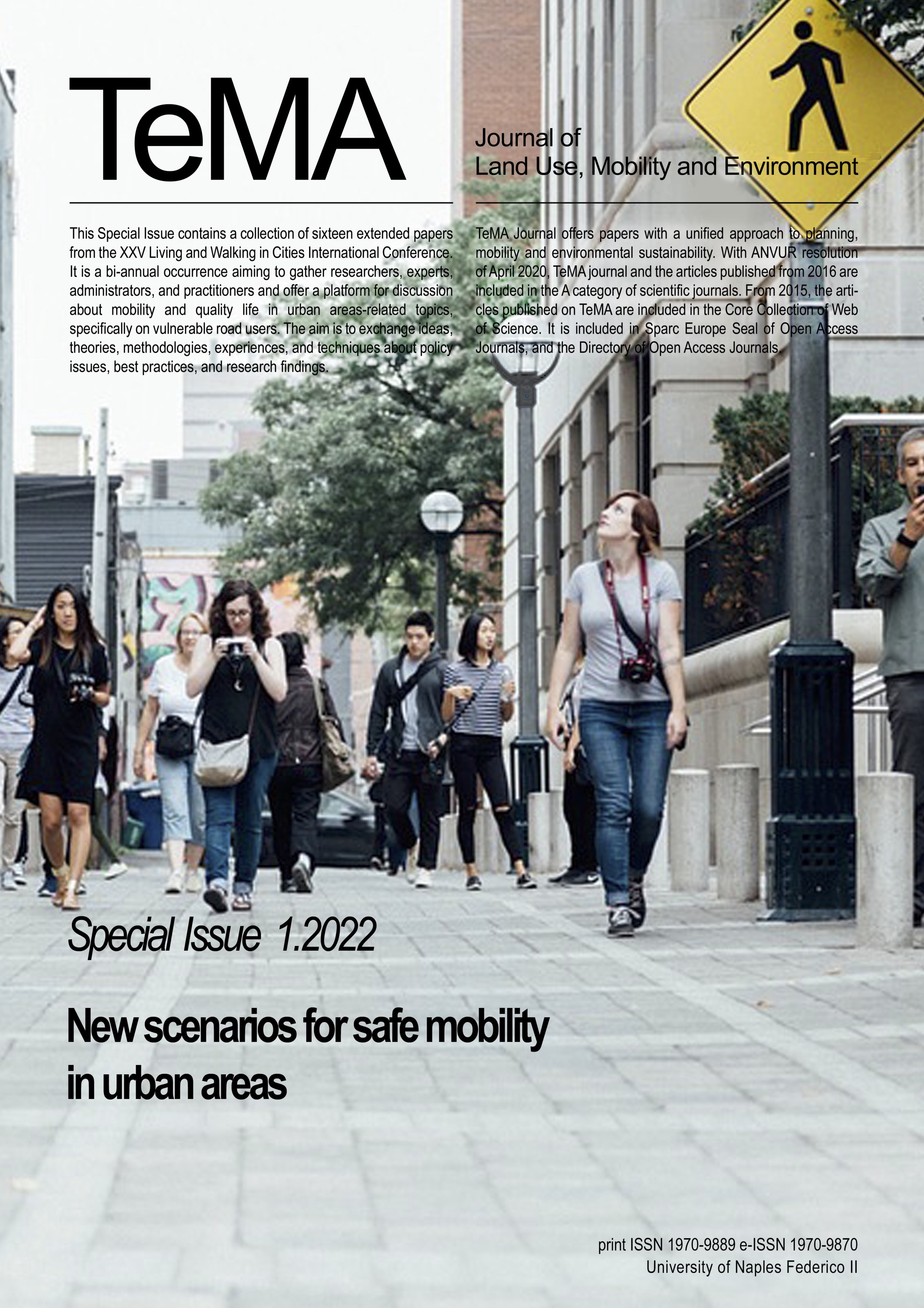Public spaces critical issues analysis for soft mobility
A methodology for the cognitive framework definition
Abstract
Over time, one of the causes that led to the progressive reduction in the public space quality is the massive diffusion of private cars. The characteristics of quality, safety, and accessibility should be indispensable for the public space, and these needs should be met through targeted interventions, with particular attention to the integration between urban planning and mobility. Therefore, in this article, we study the public spaces criticalities to promote soft mobility. A methodology is proposed for the definition of the public spaces’ cognitive framework. The methodology is based on three different phases: the urban context analysis, the analysis of the perception of space by the user, and some preparatory solutions for the subsequent design phase. Technical analyzes are based on on-site observations, measurements, data processing, and thematic maps. On the contrary, the perception phase is based on the direct involvement of citizens through a survey. The methodology is applied to the case study of the San Bartolomeo and Casazza districts of the city of Brescia. The results show a strong connection between the urban spaces geometric characteristics and their perception by users, useful for the design of a public space weighted to the needs encountered.
Downloads
References
Allegretti, U. (2011). Modelli di partecipazione e governance territorial: prospettive per i processi partecipativi nei comuni ‘dopo’ le circoscrizioni. Istituzioni Del Federalismo, 193-214.
Angelucci, F., & Di Sivo, M. (2018). Il macro requisito dell'accessibilità integrata per la healthy city. In A. F, Smartness e healthiness per la transizione verso la resilienza (p. 185-204). Milano: FrancoAngeli.
Bertolini, L. (2017). Planning the Mobile Metropolis. Transport for People, Places and the Planet. London: Red Globe Press.
Boglietti, S., Barabino, B., & Maternini, G. (2021). Survey on e-Powered Micro Personal Mobility Vehicles: Exploring Current Issues towards Future Developments. Sustainability, 13 (7)(3692). doi:10.3390/su13073692
Carra, M., Ferretti, E., Levi, N., Sgarbi, G., & Testoni, C. (2018). From community partecipation to co-design: Quartiere Bene Comune case study. Journal of Place Management and Development, 11(2), 242-258. doi:https://doi.org/10.1108/JPMD-06-2017-0046
Cecchini, A., Congiu, T., Talu, V., & Tola, G. (2018). Mobility policies and extra-small projects for improving mobility of people with autism spectrum disorder. Sustainability, 10(9), 3256.
Colarossi, P., Pezzagno, M., & Tira, M. (2007). Gli spazi urbani. In A. Arenghi (A cura di), Design for all. Progettare senza barriere architettoniche (p. 75-122). Torino: UTET.
Ghel, J. (1991). Vita in città. Rimini: Maggioli Editore.
Giuffrida, N., Le Pira, M., Inturri, G., & Ignaccolo, M. (2019). Mapping with Stakeholders: An Overview of Public Participatory GIS and VGI in Transport Decision-Making. ISPRS International Journal of Geo-Information, 8(4), 198.
Gonzalez-Urango, H., Inturri, G., Le Pira, M., & García-Melón, M. (2020). Planning for Pedestrians with a participatory multicriteria approach. Journal of Urban Planning and Development, 146(3), 05020007.
Ignaccolo, M., Inturri, G., Giuffrida, N., Le Pira, M., & Torrisi, V. (2019). Public engagement for designing new transport services: investigating citizen preferences from a multiple criteria perspective. Transportation Research Procedia, 37, 91-98.
Le Pira, M., Inturri, G., Ignaccolo, M., & Pluchino, A. (2017). Modelling consensus building in Delphi practices for participated transport planning. Transportation Research Procedia, 25, 3725-3735.
Mahapatra, G., Mori, S., & Nomura, R. (2021). Universal Mobility in Old Core Cities of India: People’s Perception. Sustainability, 13, 4391.
Muhlrad, N. (2000). A Short History of Physical Speed Reduction Measures in European. ICTC Extraordinary Workshop on Traffic Calming. New Delhi.
Rossetti, S. (2020). Planning for Accessibility and Safety. Theoretical framework and research methodologies to address people friendly mobility. Maggioli Editore.
Rossetti, S., Tiboni, M., & Tira, M. (2014). Road safety in Italy: An assessment of the current situation. Periodica Polytechnica Transportation Engineering, 42(2), p. 159-165.
Tiboni, M. (2004). Pianificazione urbanistica e sicurezza stradale. Cosenza: Editoriale BIOS.
Tiboni, M. (2010). Storia della moderazione del traffico in Europa e sue implicazioni urbanistiche. In G. Maternini, & S. Foini, Tecniche di moderazione del traffico, Linee guida per l'applicazione in Italia (p. 23-36). Forlì: Egaf.
Tiboni, M., & Rossetti, S. (2013). Integrazione tra pianificazione urbanistica e della mobilità:. XVI Conferenza Nazionale Società Italiana degli Urbanisti, Urbanistica per una diversa crescita, 2.
Tira, M. (1995). Verso un ambiente urbano più sicuro.
Tira, M., Tiboni, M., Rossetti, S., & De Robertis, M. (2018). “Smart” Planning to Enhance Nonmotorised and Safe Mobility in Today’s Cities. In R. Papa, R. Fistola, & C. Gargiulo, Smart Planning: Sustainability and Mobility in the Age of Change. Green Energy and Technology. (p. 201-213). Cham: Springer. Tratto da https://doi.org/10.1007/978-3-319-77682-8_12
Wefering, F., Rupprecht, S., Bührmann, S., & Böhler-Baedeker, S. (2014). Guidelines. developing and implementing a sustainable urban mobility plan. Rupprecht Consult – Forschung und Beratung GmbH.
Copyright (c) 2022 TeMA - Journal of Land Use, Mobility and Environment

This work is licensed under a Creative Commons Attribution 4.0 International License.
Authors who publish in this journal agree to the following:
1. Authors retain the rights to their work and give in to the journal the right of first publication of the work simultaneously licensed under a Creative Commons License - Attribution that allows others to share the work indicating the authorship and the initial publication in this journal.
2. Authors can adhere to other agreements of non-exclusive license for the distribution of the published version of the work (ex. To deposit it in an institutional repository or to publish it in a monography), provided to indicate that the document was first published in this journal.
3. Authors can distribute their work online (ex. In institutional repositories or in their website) prior to and during the submission process, as it can lead to productive exchanges and it can increase the quotations of the published work (See The Effect of Open Access)

